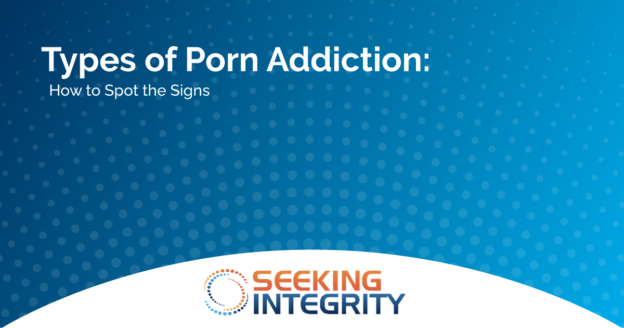Types of Porn Addiction
Most porn addicts have a lengthy history of early-life trauma—physical neglect, emotional neglect, physical abuse, sexual abuse, cover incest, etc. This puts porn addicts in line with alcoholics, drug addicts, compulsive gamblers, and the like.
Recently, however, we have encountered a new and growing subcategory of individuals who struggle with pornography. These are individuals who meet the basic criteria for porn addiction but lack the underlying early-life trauma that typically drives such an addiction. Rather than qualifying as traditional trauma-driven porn addicts, it appears these individuals have developed a conditioned addiction to pornography. Seeking Integrity is a porn addiction rehabilitation facility, and we’ve helped many recover from pornography addiction.
Brain Buzz Porn Addicts
Another way to refer to conditioned porn addicts is to call them “brain buzz” porn addicts. Typically, these porn users start viewing porn at a young age, often before puberty hits, and then fail to move beyond this easily accessed sexual outlet. They discover porn early, and they learn that pornography gives them a neurobiological rush of dopamine and adrenaline—the same neurochemicals that flow with drugs like cocaine. They enjoy that buzz, so they go back to porn again and again.
For these individuals, porn serves over time as a way to get high, as a means of sexual fulfillment, and as a primary form of sex education. Thanks to the last of these (porn as sex education), the user’s emotional and psychological development in terms of sex and relationships is stunted—beginning and ending with what they learn from porn. As such, their ability to form and maintain meaningful real-world romantic and sexual attachments does not develop (or does not fully develop in the usual ways).
Brain Balancer Porn Addicts
Over time, escape and avoidance porn addicts become brain balancer addicts. In this respect, they are like alcoholics, drug addicts, compulsive gamblers, and pretty much every other type of addict. They develop an addictive call and response to emotional and psychological disturbances, and that response is to numb their feelings by ingesting a potentially addictive substance or engaging in a potentially addictive behavior.
These porn addicts escape and avoid the ongoing emotional pain of neglect, abuse, and inconsistent parenting, as well as in-the-moment issues like stress, boredom, and anxiety. They do this by escaping into sexual fantasies, which are aided and abetted by pornographic videos, photos, and words. In other words, these men and women repeatedly and compulsively choose to self-medicate and self-soothe all forms of emotional discomfort with pornography, erotica, and sexualized fantasy.
Escape Porn Addicts
Traditional “escape” porn addicts are driven by complex (multi-layered) early-life trauma. These individuals learn as kids that an effective way to escape the pain of their abusive, traumatic, or neglectful upbringing is to numb out emotionally—to escape through use of a pleasure-inducing substance or behavior. Sometimes these individuals discover alcohol and drugs; other times they discover masturbation, pornography, video gaming, gambling, and the like. Whatever the substance or behavior, they use it less to have a good time and more to escape emotional discomfort.
Avoidance Porn Addicts
Another term for escape porn addicts is “avoidance” porn addicts. These individuals seek to control their emotions by avoiding them by using pornography. Basically, pornography triggers a neurochemical pleasure response that helps them temporarily avoid whatever in-the-moment unpleasant feelings they’re having—stress, anxiety, loneliness, boredom, shame, etc. Over time, porn becomes their go-to coping mechanism, no matter what is happening. Basically, they have an uncomfortable feeling, and they automatically and without conscious thought turn to pornography to avoid that feeling.
Re-Enactment Porn Addicts
With porn addicts, one of the most common forms of early-life pain involves either overt or covert sexual trauma. Overt sexual trauma is exactly what it sounds like: “hands-on” sexual abuse. Covert sexual trauma is more subtle. First discussed by Dr. Ken Adams, covert sexual abuse is the surreptitious, indirect, sexualized use/abuse of a child by a parent, stepparent, or any other long-term caregiver. Covert sexual abuse involves indirect (not hands-on) sexuality—sexuality that is implied or suggested rather than physically acted out.
Even though covertly incestuous relationships do not involve overt sexual abuse, they are sexualized in nature, and the victims respond over time in the same ways as overt incest survivors. Basically, sexually abused children are robbed of healthy attachment bonds, emotional growth, and many other basics of childhood relational development. As a result, they typically experience one or more of the following as adults:
- Addiction, especially sex and porn addiction
- Difficulty developing and maintaining emotional intimacy
- Shame and feelings of inadequacy, especially around sex
- Difficulties with self-care
- Feeling overwhelmed by sexual and relational intimacy
- Inappropriate sexual and relational bonding
- Reenactment of sexual trauma
This last issue, reenactment of sexual trauma, is especially common in sexual abuse survivors. Basically, they attempt to control the uncontrollable (the sexual abuse they suffered) by eroticizing it. As such, they will relive the abuse, through actions or pornography, but this time they are the one in control. They may fantasize themselves as still being the victim, or they may think of themselves in their fantasy as the perpetrator. Either way, the action is their choice. This time, they are in control.
Seeking Help for Porn Addiction in Sherman Oaks, California
Many (perhaps most) of the clinicians who treat porn-related issues are unaware of the difference between traditional (trauma-driven) porn addicts and conditioned (brain buzz) porn addicts. This is partly because the two categories, on the surface, look the same, and partly because clinicians have not yet been taught to look for the subtle differences. Thus, they treat all struggling porn users with the same approach and methodology. In the early stages of recovery, this is not an issue, as the same initial interventions are effective with both cohorts. Longer-term, however, because the underlying etiology is different, treatment should also differentiate.
With both traditional and conditioned porn addiction, early treatment includes both individual and group therapy—nearly always a behavior-focused modality such as Cognitive Behavioral Therapy (CBT) or Dialectical Behavior Therapy (DBT)—paired with social learning, psychoeducation, workgroups, and 12-step or other recovery-focused support groups.
In the longer-term, treatment of traditional porn addicts shifts toward processing and resolving the addict’s underlying trauma issues—the underlying reasons the individual compulsively seeks emotional and psychological escape through pornography. With conditioned porn addicts, rather than looking at trauma, treatment moves into the who, what, when, where, why, and how of real-world relationships.
Whatever category of porn addiction that you or a loved one are dealing with, Seeking Integrity can help. We offer residential rehab and online workgroups for porn addicts. For more information, please contact us via email or call us at 747-300-0998.
FAQs
What does porn addiction look like?
Porn addicts spend countless hours searching for and looking at pornography. And loss of time is just the beginning of porn’s negative impact on addicts and their loved ones. Porn addicts often couple their porn use with compulsive masturbation. They may also link their porn use to other compulsive sexual behaviors, such as webcamming, sexting, casual hookups, affairs, prostitution, etc. That said, porn addiction can be and often is a standalone form of addiction.
How is porn addiction diagnosed?
Porn addiction is diagnosed based on three primary criteria:
Preoccupation to the point of obsession. Porn addicts spend hours, sometimes even days, fantasizing about, planning for, pursuing, and eventually using pornography.
Loss of control. Most porn addicts try, usually repeatedly, to quit their use of pornography. Sometimes they even succeed for a short while. But before they know it, they are back at it.
Negative consequences. Porn addicts typically experience issues at work or in school, relationship woes, shame, depression, anxiety, loss of interest in previously enjoyable activities, isolation, arrest, etc.
If you identify with these criteria, it is likely you are addicted to pornography. If you are uncertain, we suggest you take this anonymous 25-question sex and porn addiction screening test.
Where should I go for treatment?
Porn addiction is treatable, but only if the addict seeks the right type of professional assistance. Unfortunately, very few facilities specialize in porn addiction the way that Seeking Integrity does. In fact, most places just lump porn addiction in with every other form of addiction, attempting a “one size fits all” version of recovery. Porn addicts do not respond well to that approach. It is only with specialized porn addiction treatment, such as the treatment we provide at Seeking Integrity, that the addict’s true problem and its underlying factors are addressed.


